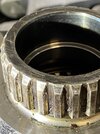The pros and cons, availability, and much else has been covered in the preceding 19 pages, so I'll just add my views. First, several here have departed from their beloved ST, to be replaced for sundry reasons by the German bikes which share the shaft drive in common. Well, the principle anyway, if not the exact parts. Many of the recent swaps are to the new shift-cam BMW 1250 series, and after decades of successful reliability in the older models, so the new 36k "free" shaft testing and swap is a mystery to me as well.
Second, the 2005-ish final drive redesign resulted in several well-publicized failures (if not many failures, although those whose d/s failed told stories that may have increased the perceived actual failure rate) for a couple of years, which also resulted in several very high profile BMW devotees switching to the GoldWing. Around 2005 - 2007 there were not many choices for a shaft drive motorcycle, so Honda and BMW remained the most popular if shaft was a Rider requirement. HOWEVER! the vast majority of these BMW failures were ultimately traced to improper torque spec on assembly at the factory of the new style "big bearing", as It was called. These were easily identified by the large, unmistakable "hole" in the rear hub, unlike any other previous model of BMW.
I know of this because I rode a chain driven single, the F650GS at the time, so was part of the "BMW culture" and wished for the big 1200, so I followed the debacle closely. In addition to this, I knew several Iron Butt Rally riders (not just the IBA certificate riders), and was on the ldrlist email list for long distance riders. Paul Glaves (living in Big Bend TX), widely known in the BMW community, was a certified BMW Master Mechanic and took it upon himself to dive into this issue and ultimately discovered the assembly at the Berlin factory was improperly torquing a bearing (as I recall) in some units, resulting in the until-then rare failure of the final drive itself.
Interestingly, this was around the same time these new designs also boasted "lifetime" sealed hubs, absent of any fd oil drain plug, as the thought was the gear oil never had to be changed. BMW later added a drain plug, and walked back their public stance about "lifetime" sealed hubs. As an aside, if it were anyone other than the Germans, they would have been embarrassed at their mistake, but in typical BMW fashion they never owned up to any actual "error" on their part. But I digress.
Another to me, interesting note, is the new policy of replacing the drive SHAFT doesn't actually specifically address the SPLINES, where the actual wear is occurring. The U-joint itself, is I suppose, considered part of the drive shaft but I could be mistaken about that. I still have 16k miles before my driveshaft is due to be tested again, although it was tested and passed after the recall to install that little rubber duckbill drain in the bottom of the swingarm.
In the end, I hope this drive shaft business is the only time my bike sees the inside of our local BMW service center, because with the help of BMW forums, I plan to do all the work myself. As mentioned here earlier, I don't think BMW actually addresses the issue of lube for their drive shaft splines, or at least not sufficiently for my needs.
Lastly... add to all of this (in case you didn't know), BMW has now adopted the shameful, low-down policy that they will NOT sell their factory service manuals in paper or any digital form, to the public. In my effort to be transparent and in the interest of full disclosure, many other manufacturers are not selling theirs either, but it makes me - and other beemer owners - very, very unhappy.
So, ...which moly paste should I use on my splines? (I kid.)
EDIT: and, as for the separation and application, yes. Do stir it up before you put it on stuff, as my tub of moly will separate into oil on the surface and thick grease underneath, just like my bottle of gray anti-seize does.
@Igofar calls the oil part, the "carrier", and that makes sense to me.





